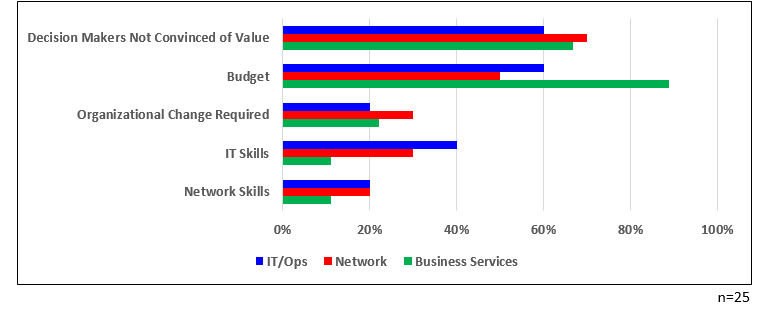
on Posted on Reading Time: 3 minutes
With the increasing growth and complexity of networks to meet the ever-escalating demand for bandwidth and new services, the need for network automation has never been greater. Broadband Success Partners recently conducted 1:1 in-depth interviews with North American and European cable MSO leaders about what is driving their network automation strategies and the resulting implications for network automation in the cable industry. To gain multiple perspectives, we spoke with 25 cable executives from Network Engineering, IT, Operations, and Business Services, across a dozen Tier-1 and Tier-2 operators.
Network Automation: Where & When?
Questions:
Each interview started with these questions:
- Have you implemented solutions that enable network automation in Next Generation Access Networks, Enterprise Business Services and Core Transport Networks?
- How far along are you?
Responses:
- Tier-1 Executives: Across all three areas, most Tier-1 executives indicated that network automation initiatives are under way or will be this year.
- Tier-2 Executives: Not surprisingly, the timing noted by Tier-2 executives lagged indications from Tier-1 executives.
Network Automation: Why?
What most drives your network automation plans? Is it the promise of:
- Improved efficiencies and lower operating expenses,
- Reduced likelihood of human error,
- Improved customer experience,
- New service offerings, or
- Enterprise business services and SLA compliance?
Responses:
- Most executives say it’s mainly driven by the promise of improved efficiencies and lower operating expense.
- Responses regarding the next most significant driver differed by MSO size:
- Tier-1s chose reduced likelihood of human error.
- Tier2s cited improved customer experience.

To understand the reasons underlying their answers, interviewees were asked why they ranked an item as the most significant.
Here are a few representative quotes for why improved efficiencies and lower operational expenses is ranked highest:
- “This is the broadest benefit for the company. Touches most things, systems, groups.”
- “We must address network complexity without adding sophisticated staff.”
- “We must eliminate swivel-chair order entry and associated errors.”
Network Automation: Why Not?
Though motivated to pursue network automation initiatives, these executives face several gaps and obstacles, which thwart their initiation or progress:
- Tier-1s: The most significant gap for Tier-1s is the problem triggered by the lack of interoperability across vendors’ different hardware and software. The overriding view is that each vendor, striving to get as much of a client’s business as possible, is not motivated to deliver open solutions. Some of the executives cited a “need to rely on standards.” Others are looking for “a tool that will work with all vendors.” In some cases, the problem is so severe that “the challenges with multi-vendor automation have kept our processes manual.”
- Tier-2s: Tier-2 executives rank “the network automation software is not advanced enough” as the greatest gap. As one executive explained, “A lot of legacy equipment doesn’t have the reporting features [telemetry] necessary to specify the parameters required to make [network automation] decisions.”
When asked about network automation obstacles, most of the executives called out the greatest obstacles to achieving further or full network automation as:
- Decision-makers (not yet convinced of the value), and
- Budgets (they have yet to approve)
When viewed on the basis of functional area, the data reveals that over 80% of those in Business Services view the greatest obstacle as the lack of budget. According to one of these executives, “We’ve yet to find the tipping point for the financial justification.”

% who rate the driver as the 1st or 2nd most significant (top 2 box scores)
The link between the budget and the decision-maker is clear in several comments:
- “Until decision-makers can see ROI, they’d rather focus on immediate priorities. Finance needs to prove ROI and convince decision-makers.”
- One executive succinctly captured the reason her decision makers are balking: “Decision-makers won’t be convinced until there’s pain. We’ve operated a long time without automation.”
How can you use these insights?
As the research reveals, the network automation journey is a multi-faceted one. As such, it’s best to start with a holistic view. Develop a comprehensive automation framework to avoid the risk of creating inefficiencies with automation islands. Even if you’ve already started your network automation journey, it’s not too late to step back and look at the bigger picture from an end-to-end perspective.
These are just a few of the findings and implications. For a more in depth perspective read the white paper entitled “Cable Move to Network Automation – Why, Why Not, Where, How and When?”
and be sure to join us, your peers and the whole network ecosystem as these and other leaders converge at MEF19 in Los Angeles, this 18-22 November exploring all things ‘automation’ including MEF’s LSO.
